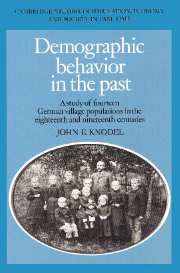 Demographic Behavior in the Past
Demographic Behavior in the Past Book contents
- Frontmatter
- Contents
- List of tables
- List of figures
- Acknowledgements
- PART I INTRODUCTION
- PART II MORTALITY
- PART III FAMILY FORMATION
- 6 Marriage
- 7 Marital dissolution and remarriage
- 8 Illegitimacy
- 9 Bridal pregnancy and prenuptial births
- PART IV MARITAL REPRODUCTION
- PART V INTERRELATIONSHIPS IN DEMOGRAPHIC BEHAVIOR
- PART VI CONCLUSION
- Appendices
- Bibliography
- Index
7 - Marital dissolution and remarriage
Published online by Cambridge University Press: 04 August 2010
- Frontmatter
- Contents
- List of tables
- List of figures
- Acknowledgements
- PART I INTRODUCTION
- PART II MORTALITY
- PART III FAMILY FORMATION
- 6 Marriage
- 7 Marital dissolution and remarriage
- 8 Illegitimacy
- 9 Bridal pregnancy and prenuptial births
- PART IV MARITAL REPRODUCTION
- PART V INTERRELATIONSHIPS IN DEMOGRAPHIC BEHAVIOR
- PART VI CONCLUSION
- Appendices
- Bibliography
- Index
Summary
Most historical investigations of nuptiality in western Europe have focused on the relatively late entry into first marriage for both sexes and the substantial proportions never married that were typical in the past. Far less attention has been paid to the patterns of marital dissolution and remarriage that were characteristic of the prevailing socio-economic and demographic systems, despite their potential significance for the individuals and societies involved.
The studies of historical patterns and trends of remarriage in Europe that have been done are usually based on data on the distribution of marriages according to the marriage order of the spouses. Results have typically revealed a substantial decline in the proportionate share of marriages involving people remarrying, and a concomitant growth in the proportion of primary marriages (those between never-married men and women). In their analysis of English trends, for example, Schofield and Wrigley argue that while 25–30 percent of those marrying in the sixteenth century were remarrying, this proportion had declined to only 10 percent by the nineteenth century. Data from local family reconstitution studies in France, including those by Cabourdin and Bideau, confirm the existence of a trend, from the sixteenth to the nineteenth century, toward a decreasing proportion of remarriages.
There has been considerably less work done on the actual probabilities and rates of remarriage. In their history of the European family, Mitterauer and Sieder assume that the probability of remarriage underwent a ‘continuous’ decline over the last two centuries, although they provide no supporting evidence.
- Type
- Chapter
- Information
- Demographic Behavior in the PastA Study of Fourteen German Village Populations in the Eighteenth and Nineteenth Centuries, pp. 153 - 184Publisher: Cambridge University PressPrint publication year: 1988


